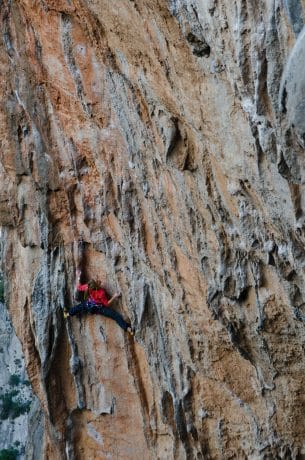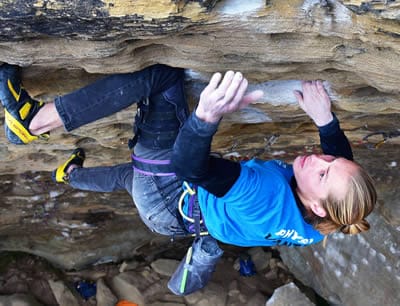Climbing near your limit with escalating tension can be stressful. Desperate moves, risk of falling, and the uncertainty of what’s next can foster unproductive thoughts and physical tension that snowballs at a rapid rate. Left unchecked, such tension will cause you to pump out and quite likely fall.
(This article was originally published in January 2015.)
Even expert climbers occasionally experience rising tension on the toughest routes; however, they are masters at controlling tension on the fly. You can develop the same awareness and control over tension as it builds in the midst of a challenge. Here are two strategies for regaining control in the midst of a difficult route.

Maintaining tension is a crucial skill for managing your energy levels and redpointing technical routes. Photo by Fiona Clayton.
1. Focus on breath control
Deep, steady breathing is the number one antidote to tension. Not surprisingly, then, the common tendency to breathe shallowly—and sometimes even hold your breath—on a difficult or scary sequence is a prime cause of tension. While it’s sometimes beneficial to hold a deep breath for a single powerful move (that requires core tension or a “bearing down”), it’s often difficult to return to a steady rhythm of breathing. By being aware of this tendency, however, you can take conscious control of your breathing during stressful times on a route. Strive for slow, deep belly breaths during the moves leading up to a crux, and try to regain steady breathing as you move out of the most difficult moves. This strategy alone will go a long way toward controlling tension as you climb.
Before you start up a route, try to predetermine the location of all rest stances and clipping positions. These spots should offer you the opportunity to take a moment to steady your breathing. Upon reaching one of these spots, close your eyes for a moment and turn your thoughts inward to feel air filling your lungs with each slow breath. As you exhale, visualize the tension exiting your body and feel a renewed sense of being centered. This entire process might only take five to fifteen seconds, but it’s invaluable for regaining an optimal state for attacking the next section of the climb. Make it a habit to steady your breathing at every rest.
2. Keep your thoughts productive and goal-oriented
Doubtful, fearful thinking is an on-sight or redpoint terminator. You simply can’t climb well with the weight of these negative thoughts in tow. Once again, you need to seize every stopping point on a route as an opportunity to tune into your internal self-talk. Is it productive or unproductive in nature? Quickly evaluate any fears to determine if they are legitimate or just phantom fears trying to scare you off the route. In sport climbing, most fears are fraudulent, and if this is indeed the case, you must write them off as illusions and then redirect your attention onto your goal—sending the route!
The popular sports metaphor “keep your eye on the ball” is appropriate here. Resist the tendency to doubt your abilities or ponder the fall potential, and simply narrow your focus onto the next section of climb. It’s best to attack a route one chunk at a time. Concentrate on the moves up to the next rest and forget about what’s below you as well as what’s yet to come above the next chunk. If your only goal is climbing the 6 feet (or whatever) to the next rest position, the burden is greatly reduced and a major cause of tension is erased.
Related articles
- Climb Better by Optimizing Your Arousal and Energy Levels
- 10 Tips for Pursuing Maximum Climbing Performance
- Overcoming the Fear of Failure
- Increasing Self-Awareness in the Pursuit of Excellence
- 5 Strategies to Sharpen Your Concentration and Climb Better!
Copyright © 2000–2015 Eric J. Hörst | All Rights Reserved.







![🚨New Training For Climbing podcast drop! [**Link in bio.**]
This a two-part deep dive into designing a comprehensive, long-term systems approach to training. Coach @eric_horst unpacks—in rich detail—how systems actually function, and he highlights how transformative climbers throughout history “shake up the box” with innovative, highly effective methods to achieve big goals and push the boundaries of our sport.
In Part 1 (#122), Eric blends a concise climbing history lesson with an engineer-like breakdown of how intelligent systems operate. Part 2 (#123) of this series will deliver the actionable strategies you can use to build a personalized, high-performance training system for this winter…and for many seasons to come.
Eric emphasizes that as climbers progress beyond the beginner stage, climbing and training grow increasingly complex—requiring intentional, organized, and year-round development of strength, technique, mental skills, recovery habits, nutrition, and lifestyle management. Rather than ad-lib sessions or singular-focus programs (like only training strength), climbers need a comprehensive system fine-tuned daily and seasonally.
This is an entertaining and thought-provoking episode—so lean in, listen closely, and get ready to feel inspired, challenged, and equipped to level-up your modus operandi at the crag, in the gym, at home, and in everything you do! Listen on Apple Podcasts, Spotify, or online using the web player below.
#climbingtraining #bouldering #indoorclimbing #climbing #climbingpodcast #erichorst #trainingforclimbing @lasportivana @physivantage](https://trainingforclimbing.com/wp-content/plugins/instagram-feed/img/placeholder.png)


